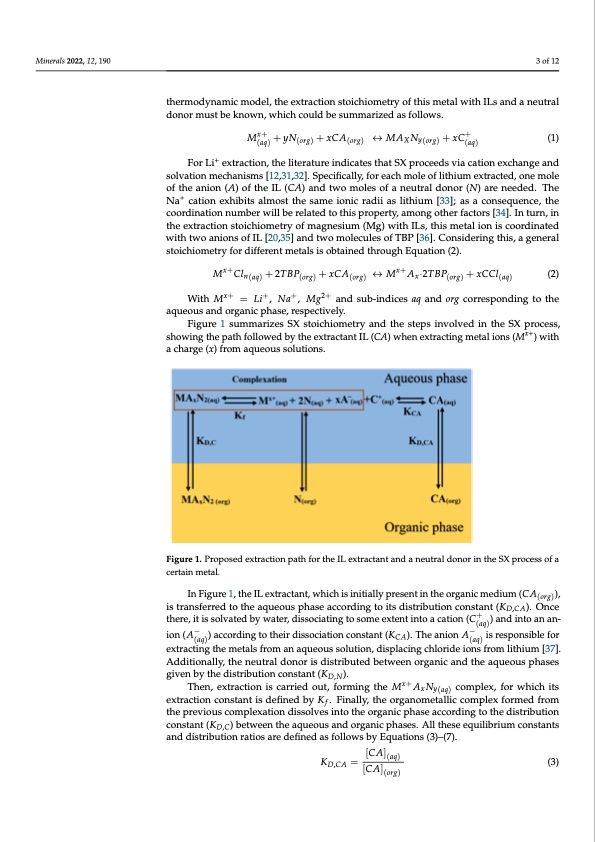
PDF Publication Title:
Text from PDF Page: 003
Minerals 2021, 11, x Minerals 2022, 12, 190 3 of 13 3 of 12 in brines, considering an extracting phase composed of a synergistic agent and different thermodynamic model, the extraction stoichiometry of this metal with ILs and a neutral hydrophobic ILs as extractants diluted in conventional organic solvents. In this thermo- donor must be known, which could be summarized as follows. dynamic model, the extraction stoichiometry of this metal with ILs and a neutral donor must be known, whxic+h could be summarized as follows. + M(aq) + yN(org) + xCA(org) ↔ MAX Ny(org) + xC(aq) (1) 𝑀 𝑦𝑁 𝑥𝐶𝐴 + () () ↔𝑀𝐴𝑁 𝑥𝐶 () () () (1) extraction, the literature indicates that SX proceeds via cation exchange and ++ For Li solvatFionr mLiecehxatrnaicstmiosn[,1t2h,3e1l,i3te2r]a. tSuprecinfidcaiclalyt,efsotrheaatcShXmporloeceoefdlisthviiuamcaetxiotrnacetxecdh,aonngemanodle osfotlhveataionniomne(cAh)anoifsmthse[I1L2,3(C1,A32)]a.nSpdetcwifiocamllyo,lefosroefaachnmeuotlreaolfdliothniourm(Nex)tararectnedee, odneed.mTohlee + etry for different metals is obtained through Equation (2). Mx+Cln(aq) +2TBP(org) +xCA(org) ↔ Mx+Ax·2TBP(org) +xCCl(aq) (2) 𝑀𝐶𝑙() 2𝑇𝐵𝑃() 𝑥𝐶𝐴() ↔ 𝑀𝐴 ∙ 2𝑇𝐵𝑃() 𝑥𝐶𝐶𝑙() (2) Noaf thceaatinoinonex(Ahi)boitfsthaelmILo(sCt Ath)eansadmtwe oiomnioclersaodfiiaanseulitrhailudmon[o33r ](;Na)saarecnoenesdeeqdu.eTnhce,Ntahe cocaotridonineaxtihoinbintsuamlmbeorstwthilelbsaemrelaiotendictroadthiisapsrliotphieurmty,[a3m3]o;ansgaoctohnersefqaucteonrcse[,3t4h]e.cInootrudrin,ai-n thtieonexnturamctbioernwstiollicbheioremlaetterdytoftmhiasgpnreospieurmty,(Mamgo)nwgitohthIeLrs,fatchtiosrms [e3t4a]l.iIonntuisrnc,oionrdthineaetxe-d wtritahcttiwonosatonicohnisomofeItLry[o20f ,m35a]gannedsiutwmo(Mmgo)lewciuthleIsLosf, tThBisPm[3e6ta].l iCoonnisicdoeorridnignathteisd, wa igthentewroal staoniicohniosmofeItLry[2f0o,r3d5]ifafenrdentwtmometaolsecisuloebstoafinTeBdPth[3r6o]u.gChonEsqidueartionngt(h2)i.s,ageneralstoichiom- x+ + + 2+ With M = Li , Na , M g and sub-indices aq and org corresponding to the With 𝑀 = 𝐿𝑖 , 𝑁𝑎 , 𝑀𝑔 and sub-indices aq and org corresponding to the aque- aqueous and organic phase, respectively. ous and organic phase, respectively. Figure 1 summarizes SX stoichiometry and the steps involved in the SX process, Figure 1 summarizes SX stoichiometry and the steps involved in the SX process, showing the path followed by the extractant IL (CA) when extracting metal ions (Mx+) wxi+th showing the path followed by the extractant IL (CA) when extracting metal ions (M ) a charge (x) from aqueous solutions. with a charge (x) from aqueous solutions. Figure 1. Proposed extraction path for the IL extractant and a neutral donor in the SX process of a Figure 1. Proposed extraction path for the IL extractant and a neutral donor in the SX process of a certain metal. certain metal. In Figure 1, the IL extractant, which is initially present in the organic medium In Figure 1, the IL extractant, which is initially present in the organic medium (CA(org)), (𝐶𝐴()), is transferred to the aqueous phase according to its distribution constant (𝐾,). is transferred to the aqueous phase according to its distribution constant (KD,CA). Once Once there, it is solvated by water, dissociating to some extent into a+cation (𝐶 ) and () there, it is solvated by water, dissociating to some extent into a cation (C(aq)) and into an an- into an anion (𝐴 ) according to their dissociation constant (𝐾 ). The anion 𝐴 is re- − () − () ion (A(aq)) according to their dissociation constant (KCA). The anion A(aq) is responsible for sponsible for extracting the metals from an aqueous solution, displacing chloride ions extracting the metals from an aqueous solution, displacing chloride ions from lithium [37]. from lithium [37]. Additionally, the neutral donor is distributed between organic and the Additionally, the neutral donor is distributed between organic and the aqueous phases aqueous phases given by the distribution constant (𝐾,). given by the distribution constant (KD,N). Then, extraction is carried out, forming the 𝑀 𝐴𝑁 complex, for which its ex- x+ traction constant is defined by 𝐾. Finally, the organometallic complex formed from the Then, extraction is carried out, forming the M extractionconstantisdefinedbyKf. Finally,theorganometalliccomplexformedfrom AxNy(aq) complex, for which its previous complexation dissolves into the organic phase according to the distribution con- the previous complexation dissolves into the organic phase according to the distribution stant (𝐾 ) between the aqueous and organic phases. All these equilibrium constants and constant(,K D,C) between the aqueous and organic phases. All these equilibrium constants distribution ratios are defined as follows by Equations (3)–(7). and distribution ratios are defined as follows by Equations (3)–(7). () KD,CA = [CA](aq) (3) [CA](org)PDF Image | Ionic Liquids for the Selective Solvent Extraction of Lithium

PDF Search Title:
Ionic Liquids for the Selective Solvent Extraction of LithiumOriginal File Name Searched:
minerals-12-00190-v3.pdfDIY PDF Search: Google It | Yahoo | Bing
Product and Development Focus for Infinity Turbine
ORC Waste Heat Turbine and ORC System Build Plans: All turbine plans are $10,000 each. This allows you to build a system and then consider licensing for production after you have completed and tested a unit.Redox Flow Battery Technology: With the advent of the new USA tax credits for producing and selling batteries ($35/kW) we are focussing on a simple flow battery using shipping containers as the modular electrolyte storage units with tax credits up to $140,000 per system. Our main focus is on the salt battery. This battery can be used for both thermal and electrical storage applications. We call it the Cogeneration Battery or Cogen Battery. One project is converting salt (brine) based water conditioners to simultaneously produce power. In addition, there are many opportunities to extract Lithium from brine (salt lakes, groundwater, and producer water).Salt water or brine are huge sources for lithium. Most of the worlds lithium is acquired from a brine source. It's even in seawater in a low concentration. Brine is also a byproduct of huge powerplants, which can now use that as an electrolyte and a huge flow battery (which allows storage at the source).We welcome any business and equipment inquiries, as well as licensing our turbines for manufacturing.| CONTACT TEL: 608-238-6001 Email: greg@infinityturbine.com | RSS | AMP |